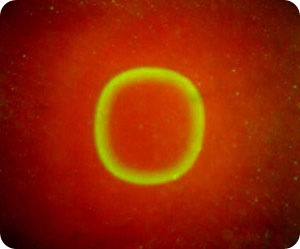Jul 13 2009
Bacteria know that they are too small to make an impact individually. So they wait, they multiply, and then they engage in behaviors that are only successful when all cells participate in unison. There are hundreds of behaviors that bacteria carry out in such communities. Now researchers at Rockefeller University have discovered one that has never been observed or described before in a living system.
In research published in the May 15 issue of Physical Review Letters, Albert Libchaber, head of the Laboratory of Experimental Condensed Matter Physics, and his colleagues, including first author Carine Douarche, a postdoc in the lab, show that when oxygen penetrates a sample of oxygen-deprived E. coli bacteria, they do something that no living community had been seen to do before: The bacteria accumulate and form a solitary propagating wave that moves with constant velocity and without changing shape. But while the front is moving, each bacterium in it isn't moving at all.
"It's like a soliton," says Douarche. "A self-reinforcing solitary wave."
Unlike the undulating pattern of an ocean wave, which flattens or topples over as it approaches the shore, a soliton is a solitary, self-sustaining wave that behaves like a particle. For example, when two solitons collide, they merge into one and then separate into two with the same shape and velocity as before the collision. The first soliton was observed in 1834 at a canal in Scotland by Scott Russell, a scientist who was so fascinated with what he saw that he followed it on horseback for miles and then set up a 30-foot water tank in his yard where he successfully simulated it, sparking considerable controversy.
The work began when Libchaber, Douarche and their colleagues placed E. coli bacteria in a sealed square chamber and measured the oxygen concentration and the density of bacteria every two hours until the bacteria consumed all the oxygen. (Bacteria, unlike humans, don't die when starved for oxygen, but switch to a non-motile state from which they can be revived.) The researchers then cracked the seals of the chamber, allowing oxygen to flow in.
The result: The motionless bacteria, which had spread out uniformly, began to move; first those around the perimeter, nearest to the seals, and then those further away. A few hours later, the bacteria began to spatially segregate into two domains of moving and non-moving bacteria and pile up into a ring at the border of low oxygen and no oxygen. There they formed a solitary wave that propagated slowly but steadily toward the center of the chamber without changing its shape.
The effect, which lasted for more than 15 hours and covered a considerable distance (for a bacteria), could not be explained by the expression of new proteins or by the addition of energy in the system. Instead, the creation of the front depends on the dispersion of the active bacteria and on the time it takes for oxygen-starved bacteria to completely stop moving, 15 minutes. The former allows the bacteria to propagate at a constant velocity, while the latter keeps the front from changing shape.
However, a propagating front of bacteria wasn't all that was created. "To me, the biggest surprise was that the bacteria control the flow of oxygen in the regime," says Libchaber. "There's a propagating front of bacteria, but there is a propagating front of oxygen, too. And the bacteria, by absorbing the oxygen, control it very precisely."
Oxygen, Libchaber explains, is one of the fastest diffusing molecules, moving from regions of high concentration to low concentration such that the greater the distance it needs to travel the faster it will diffuse there. But that is not what they observed. Rather, oxygen penetrated the chamber very slowly in a linear manner. Equal time, equal distance. "This pattern is not due to biology," says Libchaber. "It has to do with the laws of physics. And it is organized in such an elegant way that the only thing it tells us is that we have a lot to learn from bacteria."